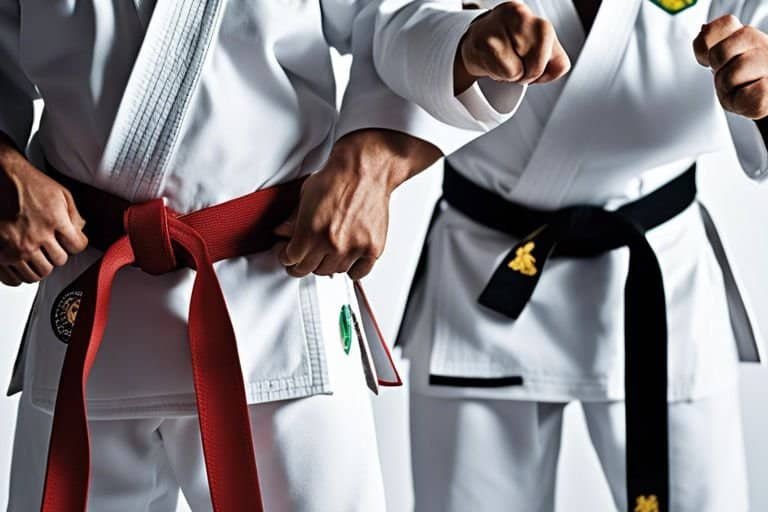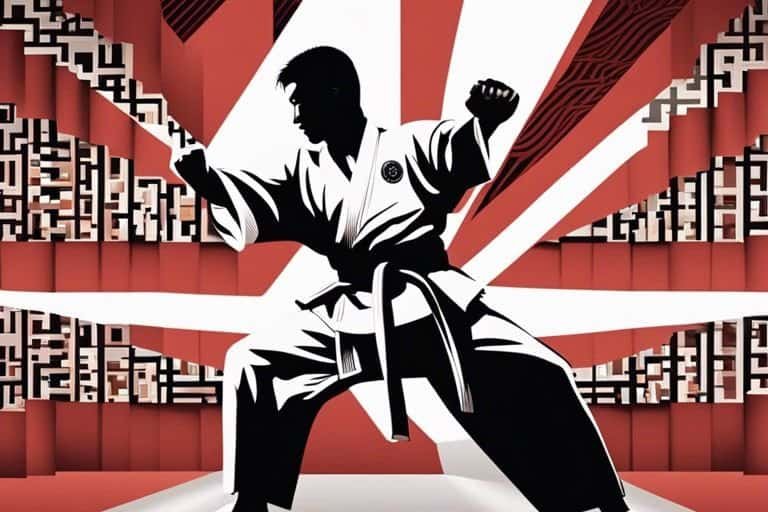Indeed, there are distinctive belt-tying techniques that are specific to certain martial arts. Across various disciplines such as karate, judo, and taekwondo, practitioners have developed their own unique methods of tying their belts, each with its own cultural significance and practical advantages. Understanding these specific techniques not only adds to the aesthetics of the martial art but also reflects a deeper connection to its traditions and values.
Key Takeaways:
- Brazilian Jiu-Jitsu: In Brazilian Jiu-Jitsu, there is a specific way to tie the belt that reflects the rank of the practitioner. The belt is tied with a double knot, with the ends of the belt facing outward for white belts, and facing inward for higher ranks.
- Judo: Judo has its own unique way of tying the belt, with a emphasis on neatness and precision. The belt must be folded in a specific manner and tied with a square knot, with the ends of the belt being of equal length.
- Karate: In Karate, the belt is tied with a specific knot known as the “square knot” or “cross knot,” which represents the four principles of the martial art. The ends of the belt are usually left hanging down unevenly, with one end longer than the other.
Belt-tying Techniques in Japanese Martial Arts
One of the most iconic elements of martial arts uniforms is the belt, and the method of tying it holds significance in many Japanese martial arts. Each martial art has its own unique way of tying the belt, and these techniques often carry deep symbolism and practical applications.
Judo: The Knot of Efficiency
Efficiency is key in Judo, and this is reflected in the way the belt is tied. The knot used in Judo is called the “Katasode” or “cross-lapel” knot, which is known for its simplicity and security. The knot is designed to stay in place during intense grappling and throwing techniques, allowing the practitioner to focus on their movements without the distraction of adjusting their belt.
Additionally, the position of the knot on the Judo belt signifies the practitioner’s rank, with the knot being placed to the left or right side depending on the level of the wearer.
Karate: The Double Wrap
One of the most distinctive belt-tying techniques in Karate is the “Double Wrap” method. Instead of simply tying the belt once around the waist, Karate practitioners wrap the belt around the body twice before tying it. This technique not only provides extra support and stability to the uniform but also carries symbolic meaning.
This unique belt-tying method is said to represent the commitment and dedication required in Karate training, as the double wrap creates a tighter and more secure hold, emphasizing the practitioner’s connection to the art and their discipline.
Belt-tying in Karate is a ritualistic and deliberate practice, with the double wrap serving as a reminder of the practitioner’s journey in martial arts, reinforcing their focus and determination.

Korean Martial Arts and Their Unique Belt Ties
While many martial arts around the world have their own specific belt-tying techniques, Korean martial arts stand out with their unique and symbolic approach to belt tying. In disciplines such as Taekwondo and Hapkido, the way a belt is tied holds significance, representing the values and principles of these ancient martial arts.
Taekwondo: The Balance Knot
Taekwondo, known for its emphasis on kicking techniques and fast-paced movements, features a distinctive way of tying the belt known as the “Balance Knot.” This knot is designed to ensure stability and balance for the practitioner during dynamic movements. It is tied firmly around the waist, allowing the practitioner to execute high kicks and swift footwork without the belt coming loose. The symbolic meaning behind the Balance Knot represents the importance of balance in one’s life and martial arts practice, serving as a constant reminder to maintain equilibrium both physically and mentally.
Hapkido: The Secure Loop
One of the hallmark features of Hapkido, a Korean martial art focusing on self-defense and joint locks, is its unique way of tying the belt called the “Secure Loop.” In Hapkido, the belt is wrapped around the waist and secured with a loop that provides extra support and firmness. This distinctive tie signifies the principle of security and control in Hapkido techniques, allowing practitioners to execute powerful joint locks and grappling maneuvers with confidence and stability.
Any discussion of Hapkido’s belt tying method also brings to mind the deep-seated emphasis on practical self-defense and the use of an opponent’s energy against them. The Secure Loop not only holds the uniform together but also reflects the efficiency and effectiveness of Hapkido’s techniques in real-life combat situations.
Brazilian Jiu-Jitsu: Mastery in Knot Complexity
Despite the numerous belt-tying techniques found across various martial arts disciplines, Brazilian Jiu-Jitsu (BJJ) stands out for its mastery in knot complexity. BJJ practitioners are known for their intricate and precisely tied belt knots that reflect the art’s emphasis on technique, precision, and attention to detail. The belt tying in BJJ is not merely a practical way to secure the gi; it is a symbol of dedication, skill, and mastery.
The BJJ Lock Tie
An essential belt-tying technique in BJJ is the Lock Tie. This technique involves wrapping the belt around the waist twice, crossing it at the back, and then bringing it around to the front to create a secure and tight knot. The precision in tying the Lock Tie is paramount, as it reflects the practitioner’s commitment to excellence and attention to detail. The intricate knot serves as a metaphor for the complexity of techniques and strategies within the art of BJJ.
Adjustments for Competition vs. Training
The Lock Tie in BJJ is not only about securing the gi; it also holds symbolic significance within the BJJ community. For competitions, practitioners often pay extra attention to the aesthetics and tightness of their belt knot, reflecting their discipline and dedication. On the other hand, during training, the focus may shift towards practicality and comfort, ensuring that the belt is secure without being overly constricting during rolling and sparring sessions.
The Symbolism of Belt Tying Across Martial Arts
For centuries, belt tying has held a significant place in the traditions of various martial arts disciplines. The intricate process of tying a martial arts belt is far more than a practical means of securing the garment; it serves as a symbolic representation of the practitioner’s journey, commitment, and devotion to the art.
Cultural Significance
Any cultural significance attached to martial arts belt tying varies across different disciplines. In some martial arts, such as Japanese and Korean traditions, the way the belt is tied and the placement of the knot hold deep cultural meanings, representing aspects such as honor, respect, and tradition. On the other hand, in disciplines like Brazilian Jiu-Jitsu, the belt itself is a symbol of personal progression and is tied with utmost care and precision to showcase dedication and achievement.
Techniques as a Reflection of Discipline and Philosophy
Significance of belt tying techniques goes beyond cultural representation to serve as a reflection of the discipline and philosophy of the martial art. Each intricate fold and knot in the process carries a philosophical meaning, emphasizing the values of patience, precision, and respect that are integral to the practice of martial arts.
Discipline in the art of belt tying mirrors the focus and dedication required in the study of martial arts. The intentional slow and meticulous nature of the process teaches the practitioner important lessons in mindfulness, persistence, and attention to detail.

Conclusion
With these considerations, it is clear that there are indeed unique belt-tying techniques specific to certain martial arts. Each martial art has its own traditions, rituals, and symbolism, which are reflected in the way practitioners tie their belts. Whether it’s the intricate and formal tying style of Japanese martial arts like karate and judo, or the simple yet symbolic tying method used in Brazilian jiu-jitsu, each technique reflects the unique history and culture of the art. Understanding and respecting these differences adds to the richness and depth of the martial arts experience, and allows practitioners to fully immerse themselves in the traditions of their chosen discipline.
FAQ
Q: Are there any unique belt-tying techniques specific to certain martial arts?
A: Yes, some martial arts have specific belt-tying techniques that hold cultural and symbolic significance. Each martial art has its own unique way of tying the belt, known as an “obi” in Japanese martial arts, such as Judo, Karate, and Aikido.
Q: What is the significance of the belt-tying techniques in martial arts?
A: The belt-tying techniques in martial arts symbolize the journey of a practitioner from a beginner to an expert. It signifies growth, discipline, and commitment to the art. Different knots and styles are used to represent the specific values and principles of each martial art.
Q: Can you provide examples of unique belt-tying techniques in specific martial arts?
A: In Judo, the belt is tied with a square knot to symbolize the strict and formal nature of the art. In Karate, the belt is often tied with a double knot and a longer end to indicate respect for tradition and humility. Aikido uses a specific way of folding the belt before tying it, representing the harmony and fluidity of the art.
Q: Are there any rules or etiquette for tying the belt in different martial arts?
A: Yes, each martial art has its own set of rules and etiquette for tying the belt. It’s important to follow the specific methods and styles as taught by the instructors to uphold the traditions and values of the martial art.
Q: How can one learn the correct belt-tying techniques for a specific martial art?
A: Learning the correct belt-tying techniques for a specific martial art involves being attentive during training and seeking guidance from experienced practitioners or instructors. It’s essential to understand the cultural and symbolic significance behind each belt-tying method to properly honor the tradition of the martial art.



